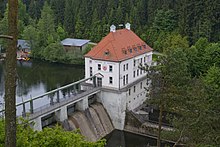Höllensteinsee
| Höllensteinsee | |||||||
|---|---|---|---|---|---|---|---|
|
|||||||
|
|
|||||||
| Coordinates | 49 ° 7 '37 " N , 12 ° 52' 4" E | ||||||
| Data on the structure | |||||||
| Construction time: | 1923-1926 | ||||||
| Height above foundation level : | 19.2 m | ||||||
| Building volume: | 25,000 m³ | ||||||
| Crown length: | 74 m | ||||||
| Data on the reservoir | |||||||
| Altitude (at congestion destination ) | 399.10 m above sea level | ||||||
| Water surface | 54.3 ha | ||||||
| Reservoir length | 5.6 km | ||||||
| Storage space | 1.6 (or 1.9) million m³ | ||||||
| Total storage space : | 2.7 million m³ (1926); 1.4 million m³ (1996) |
||||||
| Catchment area | 981 km² | ||||||
| Design flood : | 503 m³ / s (August 13, 2002) |
||||||
The Höllensteinsee is a reservoir in the Bavarian Forest , which was created 1923–1926 for the Höllenstein power plant. It is located in the municipality of the city of Viechtach between Viechtach and Bad Kötzting in the Blossersberg district and accumulates the black rain at river kilometer 112.4 over a length of 5.6 kilometers to Rugenmühle .
The 19.2 meter high gravity dam was started by Höllenstein Aktiengesellschaft (HÖLLAG) of the city of Straubing during the period of high inflation . The city needed a new power plant to generate electricity. At that time the facility was the largest dam in Bavaria.
Reservoir
The catchment area is a wooded low mountain range (70% forest) and has a height difference of around 1000 meters between the Großer Arber (1456 m) and Viechtach. The subsoil consists of granite and gneiss . The catchment area is 981 km² up to the Höllenstein dam and 998 km² up to the Pulling dam. The annual rainfall is 1160 mm. On August 13, 2002, 6:00 am, a flood peak of 503 m³ / s was measured. The minimum flow rate on August 11, 1972 was 2.2 m³ / s.
Power plant on the Höllenstein
The Höllensteinwerk was originally designed as a storage and peak power plant. After its completion, it was operated as a run-of-river power plant to generate peak electricity in surge mode. The three Francis-shaft turbines have at an expansion height of fall of 12.5 m, a design flow of 12.1 per m³ / s and a nominal speed of 250 min -1 a capacity of 1225 kilowatts. They each drive a three-phase synchronous generator, which has an electrical output of 1250 kVA at a nominal voltage of 5250 volts. The total power plant output is stated to be 3.4 megawatts and the annual standard energy capacity is 13.5 million kilowatt hours .
From 1960 to 1963, HÖLLAG also built the Pulling balancing power plant , where the discharge fluctuations caused by the swelling of the Höllensteinwerk are evenly released into the black rain. Electricity is generated again with two Kaplan turbines, each with a capacity of 595 kilowatts (together around 1.2 megawatts).
ecology
The recreational function of the Höllensteinsee was massively impaired for decades by the sewage from the Teisnach paper mill . Wastewater fungi formed extensive banks of digested sludge and reduced the storage space by 1,150,000 m³ (41%) from 1926 to 1977 . In order to counter the major problem of water pollution, after almost two years of construction and an investment of 8.5 million DM, the paper mill started up a waste liquor incineration in the fluidized bed furnace, whereby 95% of the waste water could be destroyed.
Both reservoirs, Höllenstein and Pulling, offer numerous opportunities for swimming and water sports . The Höllensteinsee is extremely idyllic and a relaxing forest area. The Pullinger Basin, also known as the Blaibacher See , is particularly popular as a swimming lake in summer. In the mouth of the Höllensteinbach near the village of Höllenstein there is an area dominated by crooked oaks, in which the rare plants arnica , soft lungwort , liverwort and spring flat pea as well as the equally rare animal species fire salamander and kingfisher can be found.
In order to achieve the passage for fish and other animals living in the water, a fish lock with energetic use of the water was built into an existing but unused bottom drainage tunnel. This previously unique principle was patented by the DPMA on December 19, 2013 .
history
As early as 1895, Siemens and Halske had the first plans for a large power source on the Schwarzen Regen, but they were never implemented. The Überlandwerke Niederbayern GmbH in Landshut submitted an application to the Viechtach district office on June 8, 1922 for the use of hydropower to generate electricity on the Schwarzen Regen. In October 1923, construction began on the Höllenstein dam and the 42 km long medium-voltage line to Straubing. The commissioning of the power plant and the start of the supply of electricity for the city of Straubing took place on January 14, 1926. In 1963 the Pulling power plant on the Blaibacher See was commissioned as a balancing power plant . The most recent water rights decision was issued on July 28, 2009 and is valid until the end of 2039.
See also
literature
- The rain. An aerial portrait from the Arber to Regensburg. Pustet, Regensburg 2007, ISBN 978-3-7917-2054-8 .
Web links
- www.prackenbach.de - Foundation and development of the Kraftwerk am Höllenstein AG
- Höllensteinsee - picture and photo impressions from the lake
Individual evidence
- ↑ a b Kraftwerk am Höllenstein AG: Information about the Höllenstein power station
- ↑ a b c d e f g h i Information board at the power plant, viewed on February 7, 2015
- ^ Christian Stierstorfer: Near-natural forest communities in the Bavarian Forest between Black Rain and Arber-Kaitersbergzug. In: Hoppea, Memoranda of the Regensburg Botanical Society , Volume 57 (1996), p. 321.





